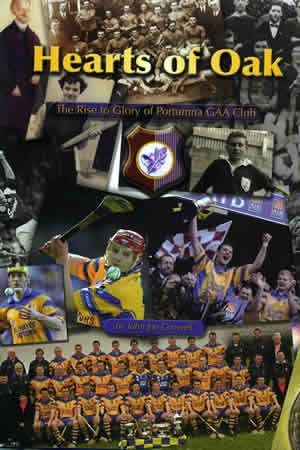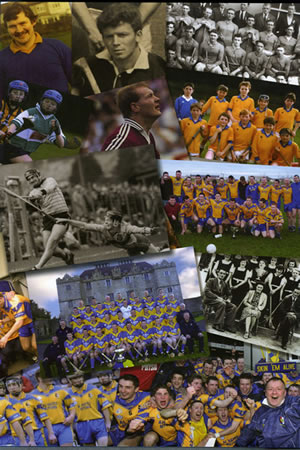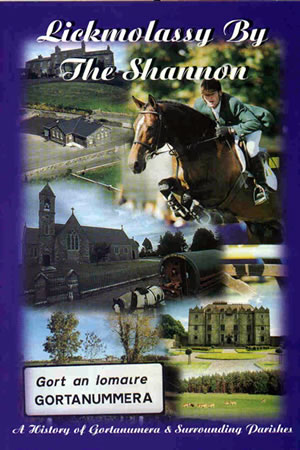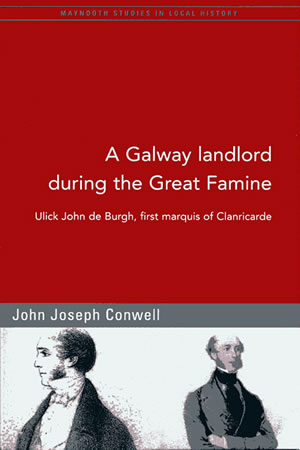John Joe Conwell - Books
The books listed below are on sale in local stores and shops in Portumna, Loughrea, Ballinasloe and Galway or can also be obtained by contacting the author at 09097 41342, Mobile 087 2963803, Email: johnjoeconwell@gmail.com.
Hearts of Oak - The rise to Glory of Portumna G.A.A. Club
Lickmolassy By the Shannon
A Galway Landlord during the Great Famine
Hearts of Oak - The rise to Glory of Portumna G.A.A. Club
 
|
On a bitterly cold St. Patrick’s Day in 2006, Portumna’s hurlers captured the All-Ireland senior hurling club title by beating well-fancied Newtownshandrum of Cork in the final at Croke Park. In winning the Tommy Moore Cup, the biggest prize in club hurling, Portumna became the fifth Galway club to lift the trophy. They won the Cup for a second time in 2008, and in doing so this Portumna team has marked itself out as one of great club teams in Galway and in the country. To acknowledge and celebrate these achievements, local historian, John Joe Conwell, compiled a history of the club entitled ‘Hearts of Oak’ - The rise to Glory of Portumna GAA Club. This 624-page publication gives an outline of the geographical territory represented by the Portumna GAA Club and briefly traces the origins of the game of hurling from prehistoric times to the setting up of the GAA in 1884. Many GAA clubs boast of a long and proud tradition in the promotion of Gaelic games but Portumna is not one of these. In the years immediately after the establishment of the GAA there is scant newspaper reference to any GAA activity in Portumna and no date is given for the formation of the club. It was 1914 before the hurlers won a county junior title and they would not repeat that feat again for another 68 years. For much of that century the club struggled to survive, its adult teams often performed poorly, and for some periods the club actually disbanded altogether. For that reason the crowning of its senior hurling team as All-Ireland club champions makes the meteoric rise to the pinnacle of success all the more remarkable. The 1920s and 1930s were lean years for the playing of gaelic games in Portumna, and although hurlers from the club were beginning to feature on county minor and junior teams it was noted more as a venue for staging hurling matches rather than for the playing of the game. The development of one of the first hurling pitches in the county at the Castle grounds in Portumna in 1930 facilitated the playing of important matches there. The most significant of these was the National Hurling League final of 1932 when Galway beat Tipperary by 4-4 to 4-5. The arrival of Fr. Walsh in the parish in 1942 gave a great boost to hurling, especially at underage level, and under his guidance three East Board minor titles along with a county title were secured in the latter years of the 1940s. The club’s juvenile hurlers also had unprecedented successes winning a string of East Board titles and a number of county titles in the 1950s and 1960s. Fr. Walsh served as East Board and County Board chairman while working in the Portumna parish. It was during this time that the second-level schools actively promoted the native games. The Vocational School opened in 1939 and St. Molaisse’s College was established in the town in 1956. Fr. Solon, a native of Whitegate, arrived in the parish in 1966 and is credited with the development of a first class hurling pitch in Portumna which was opened in 1968. He also served as chairman of the County Board and drove the Board’s underage hurling policy with vigour at county level. The Portumna GAA Club put a strong emphasis on underage hurling in the 1980s and success was achieved at every underage grade over a ten-year period. The club contested its first senior county final in 1995 against a Joe Cooney-led Sarsfields but had to wait until 2003 to make a successful breakthrough. Since then a further two senior county titles have been added along with two much-coveted All-Ireland club titles in 2006 and 2008 The book gives an account of that journey to the top. Although not regarded as a gaelic football area, the game was played in the early days before hurling became established in the parish. The club has had football teams competing at various stages down through the decades with notable successes being achieved in the late 1980s. Camogie too has prospered in the primary and second level schools within the parish and the book deals with many of the successes. The girls in Portumna Community School have enjoyed remarkable success over the past decade winning a string of Connacht junior and senior titles. This has helped to sustain a number of senior and junior camogie clubs in the area such as Davitts and Killimor and a significant number of girls have gone on to feature on county teams at various grades. The book, which contains over 600 photographs, is to be launched in the Shannon Oaks Hotel, Portumna, by former President of the GAA, Mr Joe McDonagh, on Friday night 23rd of May. The launch will be followed by the presentation of All-Ireland medals to the successful Portumna team. Doors open at 8.00 p.m. and all are welcome. The book is on sale in local stores and shops in Portumna, Loughrea, Ballinasloe and Galway or can also be obtained by contacting the author at 09097 41342, Mobile 087 2963803, Email: jjconwell@hotmail.com. The hardback version retails at €50 plus postage and packing, the softback version retails @ €30 plus postage & packing. |
Lickmolassy By the Shannon
|
Lickmolassy By the Shannon was written by local historian, John Joe Conwell, in 1998. Lickmolassy is the name given to the medieval parish situated at the north-westerly end of Lough Derg, the largest of the three lakes on the river Shannon. The parish derives its name from St Molaisses from Devenish Island whose followers established a Christian settlement in this place in the sixth century. The book traces the origins of the parish landscape from the Ice Age right through to modern times. It gives an account of the Bog Skeleton discovered in Stoneyisland townland in 1929 that has been to be over 5,000 years old. The parish has since been home to hundreds of generations of humans from pre historic man, Celt, Monk, Irish and Norman alike. They have all passed this way and left their mark on this territory nestled between the Kylecrow and Shannon rivers. The 340-page book gives an account of their journey. The book is on sale in local stores and shops in Portumna, Loughrea, Ballinasloe and Galway or can also be obtained by contacting the author at 09097 41342, Mobile 087 2963803, Email: jjconwell@hotmail.com. It retails at €15 plus postage and packing. |

|
A Galway Landlord during the Great Famine

|
Ulick John de Burgh (1802-74), first marquis and 14th earl of Clanricarde was a major Irish landed magnate with a seat at Portumna in east Galway. He belonged to one of the most influential aristocratic families in Ireland and possessed all the necessary pedigree, political connections and status to secure high political office. He was one of three Irish landowners to serve in Lord John Russell’s cabinet (1846-52). The purpose of this work is to examine the role Clanricarde, as a cabinet minister and major Galway landowner, with emphasis on his contribution to, and attitude towards, government policies on Ireland in the years prior to, and during, the Great Famine. When he entered the Brittish cabinet he was presented with an opportunity to influence government policy on Ireland during the Famine. This thesis sets out to analyse his performance. The study also endeavours to examine the immediate and long-term effects of the Famine on his 52,000-acre estate in County Galway. Clanricarde is an interesting subject for research as, to date, no detailed study has been undertaken on this wealthy Irish landed magnate and politician. The crisis precipitated by the Famine brought into sharp focus the political beliefs and philosophies of contemporary political figures and crystallised their attitudes on a range of issues such as poor law, Famine relief measures, religion, estate management, land tenure and evictions. An assessment of Clanricarde’s performance in relation to these themes contributes to the historiography of Famine period. The book briefly examines the Clanricarde family background, its long association with County Galway, and Ulick John de Burgh’s extensive estate there. Clanricarde is profiled in his personal relations, as a politician and as a landowner. It investigates his attitude to the poor law system in Ireland in the years following its introduction in 1838 and concludes with a discussion on the early months of the Famine at local level. It also analyses the various political factions comprising Lord John Russell’s administration and Clanricarde’s role and contribution to cabinet and House of Lords debates, focusing on government Famine policies and land tenure. His relationship with Irish Catholics and his role in the 1847 general election are also discussed. It considers the management of his estate in County Galway during the Famine period, concentrating on the state of Loughrea union, its workhouse and the deterioration of the town of Loughrea. The work also probes Clanricarde’s approach to evictions and examines the long-term impact of the Famine locally by considering the demographic change which occurred on his estate in the three decades between 1841 and 1871. As a politician and landowner Clanricarde moved in two distinct and separate worlds, straddling two different countries and cultures. In examining his career during the Famine period, it is important to establish if contradictions existed between his public rhetoric as a national figure and the implementation of government policies at local level in east Galway. The book is on sale in local stores and shops in Portumna, Loughrea, Ballinasloe and Galway or can also be obtained by contacting the author at 09097 41342, Mobile 087 2963803, Email: jjconwell@hotmail.com. It retails at €12 plus postage and packing. |







